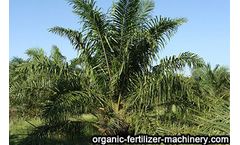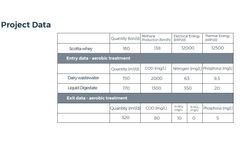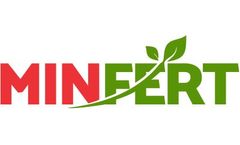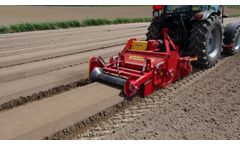Refine by
Mineral Fertilizer Articles & Analysis
33 articles found
Did you know that onions are the most cultivated crop in The Netherlands? and that it is the most widely cultivated species of the genus Allium worldwide? This crop is an herbaceous bulbous plant that is cultivated for bulb production either as biannual or perennial, depending on the cultivation conditions. Onions are among the most widely adapted vegetable crops that can be grown under a wide ...
Project The RUSTICA projects wants to provide a technical solution to convert organic residues from the fruit and vegetable sector into novel bio-based fertilizer products of high quality that can address the needs of modern (organic) agriculture. The project’s ambition goes beyond the simple recovery of nutrients, but to provide economically viable and environmentally ...
Dosage of liquid fertilizers Liquid mineral fertilizers have already proven their advantages over granular fertilizers, these namely are prolonged action and maximum absorption of the active substance. So here is the question, what is the most effective way of using liquid fertilizers? Taking into ...
Maize cropped for fodder implies return of animal manures rich in nutrients. In addition, starter fertilization with mineral P is used in cold conditions for maize cropping. It was hypothesized that the use of the additional mineral P could be excluded by increased availability of the P applied by animal manures. ...
The special oil palm fertilizer can be processed by the organic fertilizer production equipment to meet the growth needs of oil palm. Application of organic fertilizer in oil palm has incomparable advantages over chemical fertilizer 1. ...
Solid digestate is an excellent source of organic fertilizer and can be used in place of mineral fertilizers, reducing emissions of greenhouse gases. ...
Organic horticulture practiced on this farm relies on the development of healthy fertile soils through the use of soil building crops of legumes, green manures, sound rotations and additions of compost and mineral fertilisers where appropriate. ...
On the contrary to this belief, it is a proven fact that organic fertilizers do have a number of advantages over the chemical fertilizers. ...
The wide range of fertilizers can be vaguely classified in two basic types of fertilizers, Organic or Natural Fertilizers and Synthetic or Chemical Fertilizers. ...
Should I change the time of fertilization? Where do I have weed problems? Evaluate crop establishment Before winter wheat begins to grow and enter stroke phase, a map based on drone imagery can help evaluate how even the crop is within the field. ...
BySolvi AB
In addition to investing in seeds, fertilizers and plant protection products, you need the suitable equipment. ...
Together the plants produce a wide range of fertilizers that meet the requirements for fertilization of crops under varying climatic conditions and on different soils. ...
In Bowen, Queensland, in 2010, Hibrix was compared with a high NPK mineral fertiliser program for the production of maize cv. Hycorn 675IT on an alluvial sandy loam soil irrigated via sub-surface drip tape. At commercial harvest, cobs from 20 randomly selected plants per plot from were harvested, weighed and the length, girth at the cob base and length of tip not filled with kernels was measured. ...
Vinasse has been used as fertilizer by sugarcane growers, due to its potential to completely replace mineral fertilizers. ...
European farmers are currently affected by an increase in the price of fertilisers (from an index of 100 in 2005 to 150 in 2012 after it peaked at almost 200 at the end of 2008) that calls into question the future availability of these kinds of inputs. Since 2007, the strong demand from emerging countries, geopolitical tensions over natural resources, and the rise in the price of energy have been ...
These on-farm trees provide numerous benefits—they increase soil fertility and provide fodder for livestock, fruit and leaves for human consumption, fiber, firewood, and materials for traditional medicines. ...
The anthropogenic nitrogen turnover of Western societies is highly unbalanced. As a consequence, a permanent supply of nitrogen via mineral fertiliser (produced with high energy inputs) and/or imported fodder are required and result in significant impacts of nitrogen emissions on the environment (air, water, soil). Key factors to an improved nitrogen balance on a national scale are the nutrition ...
On global and continental/regional bases, we assembled nine years data on: total dry cereal grain and total dry legume seed production, production of barley, maize, rice, soybean and wheat grains/seeds, yields, area farmed, the tonnage of phosphorus and phytic acid removed in these crops and the elemental phosphorus applied as mineral fertilizers to all plant ...
Mineral P and K fertilizers were added to all plots. On average, 199 kg N ha–1, 45 kg P ha–1, 128 kg K ha–1, and 25 kg Mg ha–1 were annually added to the soil with PS29, and 354 kg N ha–1 yr–1, 79 kg P ha–1, 232 kg K ha–1, and 43 kg Mg ha–1 were annually added with PS51. Maize exported 47 kg P ha–1, 202 kg K ha–1, and 33 kg Mg ha–1 in harvested grain and stover ...
Organic resources (ORs) are important nutrient inputs in tropical agriculture. Combined with mineral fertilizers, they form the backbone of integrated soil fertility management. ...















